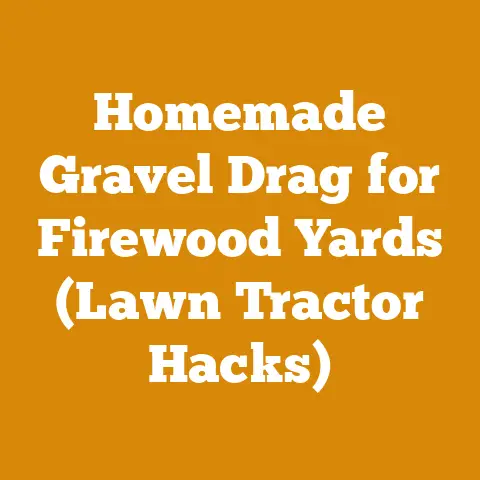How Long Will a Cord of Firewood Last? (5 Expert Insights)
I’ve always appreciated how a clean tool performs better and lasts longer. It’s the same with firewood: understanding its properties leads to better performance in your stove. So, let’s dive into the heart of the question: “How Long Will a Cord of Firewood Last? (5 Expert Insights).” I’ll share my knowledge, based on years of experience, to help you make the most of your firewood.
Understanding Firewood Consumption: 5 Key Factors
Predicting how long a cord of firewood will last isn’t an exact science. It’s more of an art, influenced by a variety of factors. Through my years of experience, I’ve identified five crucial elements that significantly impact firewood consumption.
1. Climate and Heating Needs
The severity of your local climate is the most obvious factor. If you live in a region with long, harsh winters, you’ll naturally burn through firewood at a faster rate.
- Mild Climates: In areas with average winter temperatures above freezing, a cord of firewood might last an entire heating season, especially if you’re primarily using it for supplemental heat or ambiance.
- Cold Climates: In regions with consistently sub-freezing temperatures, a single cord might only last a month or two, particularly if you rely solely on wood for heating.
My own experience in the Northeast taught me to always overestimate my firewood needs. One particularly brutal winter, I underestimated by half a cord and ended up scrambling to find more in January, when prices were at their peak. Learn from my mistake!
2. Efficiency of Your Wood-Burning Appliance
The type and efficiency of your wood-burning appliance play a huge role in firewood consumption.
- Open Fireplaces: These are the least efficient, with most of the heat escaping up the chimney. They’re primarily for aesthetics and offer minimal heating value. Expect to burn through firewood quickly.
- Traditional Wood Stoves: More efficient than open fireplaces, but still lose some heat through the chimney. Older models are generally less efficient than newer ones.
- EPA-Certified Wood Stoves: These are designed for maximum efficiency, burning wood more completely and producing less smoke. They can significantly reduce firewood consumption compared to older stoves or fireplaces.
- Fireplace Inserts: These are essentially wood stoves that fit inside an existing fireplace. They offer improved efficiency compared to open fireplaces.
I once upgraded from an old, leaky wood stove to an EPA-certified model. The difference was remarkable. I used almost 40% less firewood and the house stayed warmer, a clear demonstration of the impact of appliance efficiency.
3. Type of Wood
The type of wood you burn significantly impacts its heating value and how long it lasts. Different wood species have different densities, which directly affects the amount of heat they produce.
- Hardwoods: These are denser and burn longer, producing more heat. Examples include oak, maple, beech, ash, and birch.
- Softwoods: These are less dense and burn faster, producing less heat. Examples include pine, fir, spruce, and cedar. While softwoods are easier to ignite, they require more frequent refueling.
Here’s a general comparison of common firewood types, measured in BTUs (British Thermal Units) per cord:
| Wood Type | BTUs per Cord (approximate) | Burn Rate |
|---|---|---|
| Oak | 24-30 million | Slow |
| Maple | 20-26 million | Medium |
| Birch | 20-24 million | Medium |
| Ash | 20-24 million | Medium |
| Pine | 12-18 million | Fast |
| Spruce | 12-16 million | Fast |
I always recommend sticking to hardwoods whenever possible. While softwoods can be useful for starting fires, they’re not ideal for sustained heating. I recall a time when I tried to save money by burning mostly pine. I ended up using almost twice as much wood to achieve the same level of warmth, negating any initial cost savings.
4. Moisture Content of the Wood
The moisture content of your firewood is critical to its efficiency and how long it will last. Green wood, freshly cut, contains a high amount of moisture, making it difficult to ignite and burn efficiently.
- Seasoned Wood: This is wood that has been properly dried, typically for at least six months, to reduce its moisture content. Seasoned wood burns hotter, cleaner, and more efficiently.
- Green Wood: This is freshly cut wood with a high moisture content. It’s difficult to light, produces a lot of smoke, and burns inefficiently.
Ideally, firewood should have a moisture content of 20% or less. You can use a moisture meter to check the moisture content of your wood. I’ve found that properly seasoned wood not only burns longer but also produces significantly less creosote, reducing the risk of chimney fires.
One winter, I made the mistake of burning wood that I thought was seasoned, but wasn’t. It smoked like crazy, barely produced any heat, and left a thick layer of creosote in my chimney. I learned my lesson the hard way: always check the moisture content!
5. Your Burning Habits
Your burning habits significantly impact how long a cord of firewood lasts.
- Continuous Burning: Maintaining a consistent fire, rather than letting it die down and then re-lighting it, is more efficient.
- Airflow Control: Adjusting the airflow to your wood stove or fireplace insert can control the burn rate and heat output.
- Loading Techniques: How you load the wood into your stove or fireplace can also affect its efficiency.
I’ve found that loading wood in a “top-down” configuration, where you place larger pieces on the bottom and smaller pieces on top, can result in a longer, more consistent burn. Experiment with different loading techniques to find what works best for your appliance.
Takeaway: Several factors impact how long a cord of firewood lasts, including climate, appliance efficiency, wood type, moisture content, and burning habits. Understanding these factors will help you better estimate your firewood needs and maximize its efficiency. Next, I’ll explain how to accurately measure a cord of firewood.
How to Accurately Measure a Cord of Firewood
Ensuring you receive the correct amount of firewood is crucial. A “cord” is a specific unit of measurement, but it’s often misunderstood. I’ll break down the definition of a cord and provide tips for verifying your firewood delivery.
What Defines a Cord of Firewood?
A standard cord of firewood is defined as a tightly stacked pile of wood measuring 4 feet high, 4 feet wide, and 8 feet long. This equates to 128 cubic feet. It’s important to note that this measurement includes the air space between the pieces of wood.
- Full Cord: 4 feet x 4 feet x 8 feet = 128 cubic feet
- Face Cord (or Rick): This is a less precise term, referring to a stack of wood that is 4 feet high and 8 feet long, but the depth can vary. The price of a face cord should be adjusted accordingly.
- Loose Measurement: Avoid buying firewood sold by “truckload” or “pile” without a clear definition of the volume. These terms are too vague and leave room for misinterpretation.
I once received a delivery of what was advertised as a “full cord” that turned out to be significantly less. I learned to always measure the stack after delivery and to clearly define the dimensions with the seller beforehand.
Steps to Verify Your Firewood Delivery
- Measure the Stack: After the firewood is delivered, measure the height, width, and length of the stack.
- Calculate the Volume: Multiply the height, width, and length to determine the total cubic footage.
- Compare to a Cord: If the volume is significantly less than 128 cubic feet, you may have been shorted.
- Negotiate with the Seller: If you believe you received less than a full cord, contact the seller and discuss a fair resolution.
Here’s an example: Let’s say your delivered stack measures 4 feet high, 4 feet wide, and 7 feet long.
- Volume = 4 feet x 4 feet x 7 feet = 112 cubic feet.
- This is less than a full cord (128 cubic feet), so you should discuss this with the seller.
What to Do if You Suspect You’ve Been Shorted
If you suspect you’ve been shorted on your firewood delivery, here’s what I recommend:
- Document Everything: Take photos of the stack and your measurements.
- Contact the Seller: Politely explain the discrepancy and provide your measurements.
- Negotiate a Resolution: Aim for a fair resolution, such as a partial refund or additional firewood.
- Report to Authorities: If you can’t reach a satisfactory agreement, consider reporting the seller to your local consumer protection agency.
Takeaway: Understanding the definition of a cord and verifying your firewood delivery are essential to ensure you’re getting what you paid for. Always measure the stack and negotiate with the seller if there’s a discrepancy. Now, let’s explore how to calculate your personal firewood needs.
Calculating Your Firewood Needs: A Personalized Approach
Estimating how much firewood you’ll need for the heating season requires a personalized approach, considering your specific circumstances. I’ll guide you through a step-by-step process to determine your firewood requirements.
Assessing Your Heating Needs
Start by evaluating your overall heating needs.
- Primary Heating Source: If you rely solely on wood for heating, you’ll need significantly more firewood than if you’re using it as a supplemental source.
- Supplemental Heating: If you use wood to supplement your primary heating system (e.g., furnace, heat pump), you’ll need less firewood.
- Frequency of Use: How often do you plan to use your wood-burning appliance? Daily? Weekends only? This will impact your firewood consumption.
I remember one winter when I decided to rely solely on wood for heating to save on electricity bills. I quickly realized that I needed almost twice as much firewood as I had initially estimated, a lesson in the importance of accurate assessment.
Estimating Firewood Consumption
Based on your heating needs, you can estimate your firewood consumption.
- Mild Climates (Supplemental Heating): 1-2 cords per season.
- Cold Climates (Supplemental Heating): 2-4 cords per season.
- Cold Climates (Primary Heating): 4-8 cords per season or more, depending on the severity of the winter and the size of your home.
These are just estimates. To refine your calculation, consider the following:
- Square Footage of Your Home: Larger homes require more heat.
- Insulation Quality: Well-insulated homes retain heat better, reducing firewood consumption.
- Efficiency of Your Appliance: As discussed earlier, a more efficient appliance will use less firewood.
Using a Firewood Consumption Calculator
Several online firewood consumption calculators can help you estimate your needs. These calculators typically ask for information about your location, home size, insulation, and appliance efficiency. While they provide a helpful starting point, remember that they are still estimates.
I’ve found that using a combination of online calculators and my own experience provides the most accurate estimate. It’s always better to overestimate slightly than to run out of firewood in the middle of winter.
Tracking Your Firewood Usage
The best way to determine your firewood needs is to track your usage over time.
- Start with an Initial Estimate: Based on the factors above, make an initial estimate of how much firewood you’ll need.
- Record Your Usage: Keep track of how much wood you burn each week or month.
- Adjust Your Estimate: Based on your actual usage, adjust your estimate for the following year.
I started tracking my firewood usage several years ago, and it’s been invaluable in helping me plan for each heating season. I now have a much more accurate understanding of my firewood needs than I did when I was just guessing.
Takeaway: Accurately estimating your firewood needs requires a personalized approach, considering your heating needs, climate, home size, insulation, and appliance efficiency. Track your usage over time to refine your estimates and avoid running out of firewood. Now, let’s discuss how to properly season firewood.
The Art and Science of Seasoning Firewood
Properly seasoning firewood is crucial for efficient burning and reducing smoke and creosote buildup. I’ll explain the science behind seasoning and provide practical tips for drying your firewood effectively.
Why Seasoning Matters
Seasoning firewood reduces its moisture content, making it burn hotter, cleaner, and more efficiently. Green wood can contain up to 50% moisture, which must be evaporated before the wood can burn properly.
- Increased Heat Output: Seasoned wood produces significantly more heat than green wood.
- Reduced Smoke: Seasoned wood burns with less smoke, reducing air pollution and improving visibility.
- Less Creosote: Seasoned wood produces less creosote, reducing the risk of chimney fires.
- Easier to Ignite: Seasoned wood is much easier to light than green wood.
I’ve experienced firsthand the difference between burning seasoned and unseasoned wood. The seasoned wood lights quickly, burns hot and clean, and leaves very little ash. The unseasoned wood, on the other hand, smolders, produces a lot of smoke, and leaves a thick, tarry residue in my chimney.
The Science of Drying
Seasoning firewood involves allowing the moisture within the wood to evaporate. Several factors influence the drying process:
- Airflow: Good airflow is essential for removing moisture from the wood.
- Sunlight: Sunlight helps to warm the wood and accelerate evaporation.
- Temperature: Warmer temperatures promote faster drying.
- Wood Species: Some wood species dry faster than others.
Best Practices for Seasoning Firewood
- Split the Wood: Splitting the wood increases its surface area, allowing it to dry faster. I always split my firewood as soon as possible after cutting it.
- Stack the Wood Properly: Stack the wood in a single row, with space between each piece to allow for airflow.
- Elevate the Stack: Elevate the stack off the ground to prevent moisture from wicking up from the soil. I use pallets or scrap lumber to create a raised platform.
- Choose a Sunny Location: Locate the stack in a sunny, well-ventilated area.
- Cover the Top: Cover the top of the stack with a tarp or roofing material to protect it from rain and snow. Leave the sides open to allow for airflow.
- Allow Sufficient Time: Allow the wood to season for at least six months, and preferably longer. Hardwoods typically require longer seasoning times than softwoods.
Here’s a simple stacking method I’ve used for years: I create a raised platform with pallets, stack the split wood in a single row, leaving a few inches between each piece, and then cover the top with a tarp, securing it with bungee cords. This method provides excellent airflow and protection from the elements.
Determining When Firewood is Seasoned
The best way to determine if your firewood is seasoned is to use a moisture meter. Aim for a moisture content of 20% or less.
Here are some other indicators:
- Cracks in the End Grain: Seasoned wood typically has cracks in the end grain.
- Lighter Weight: Seasoned wood is noticeably lighter than green wood.
- Color Change: Seasoned wood often has a grayish or weathered appearance.
- Sound: When struck together, seasoned wood produces a hollow sound, while green wood produces a dull thud.
Takeaway: Properly seasoning firewood is essential for efficient burning, reducing smoke and creosote, and maximizing heat output. Split the wood, stack it properly, provide good airflow, and allow sufficient time for drying. Now, let’s review the best wood-burning practices.
Best Wood-Burning Practices for Efficiency and Safety
Efficient and safe wood-burning practices are essential for maximizing heat output, minimizing environmental impact, and preventing chimney fires. I’ll share my top tips for responsible wood burning.
Choosing the Right Wood
- Prioritize Hardwoods: As discussed earlier, hardwoods provide more heat and burn longer than softwoods.
- Avoid Treated Wood: Never burn treated wood, as it can release toxic chemicals into the air.
- Avoid Painted Wood: Avoid burning painted wood, as the paint can release harmful fumes.
Starting a Fire Efficiently
- Use Kindling and Tinder: Start with small pieces of dry kindling and tinder to establish a flame.
- Gradually Add Larger Pieces: Once the kindling is burning well, gradually add larger pieces of firewood.
- Top-Down Burning: Consider using the top-down burning method, where you place larger pieces on the bottom and smaller pieces on top. This can result in a longer, more consistent burn.
I’ve found that using a fire starter made from dryer lint and wax is a simple and effective way to get a fire going quickly.
Maintaining a Clean Burn
- Provide Adequate Airflow: Ensure that your wood-burning appliance has adequate airflow to support combustion.
- Burn Hot Fires: Hotter fires burn more efficiently and produce less smoke.
- Avoid Smoldering Fires: Smoldering fires produce a lot of smoke and creosote.
- Regularly Remove Ashes: Remove ashes from your wood-burning appliance regularly to maintain airflow and prevent buildup.
Safety Considerations
- Install and Maintain Smoke Detectors: Install smoke detectors on every level of your home and test them regularly.
- Install and Maintain Carbon Monoxide Detectors: Install carbon monoxide detectors near your sleeping areas and test them regularly.
- Have Your Chimney Inspected and Cleaned Regularly: Have your chimney inspected and cleaned by a qualified professional at least once a year.
- Keep a Fire Extinguisher Nearby: Keep a fire extinguisher nearby and know how to use it.
- Never Leave a Fire Unattended: Never leave a fire unattended, especially when children or pets are present.
- Dispose of Ashes Safely: Dispose of ashes in a metal container with a tight-fitting lid. Keep the container away from flammable materials.
I had a close call several years ago when a chimney fire started due to creosote buildup. Thankfully, I had working smoke detectors and was able to extinguish the fire quickly. This experience reinforced the importance of regular chimney inspections and cleaning.
Environmental Considerations
- Burn Seasoned Wood: Burning seasoned wood reduces smoke emissions and improves air quality.
- Use an EPA-Certified Appliance: EPA-certified wood stoves and fireplace inserts are designed to burn wood more cleanly and efficiently.
- Avoid Burning on Air Quality Alert Days: Avoid burning wood on days when air quality is poor.
Takeaway: Efficient and safe wood-burning practices are essential for maximizing heat output, minimizing environmental impact, and preventing chimney fires. Choose the right wood, start fires efficiently, maintain a clean burn, prioritize safety, and consider environmental factors.






